2019 Embedded Markets Study by EETimes and Embedded
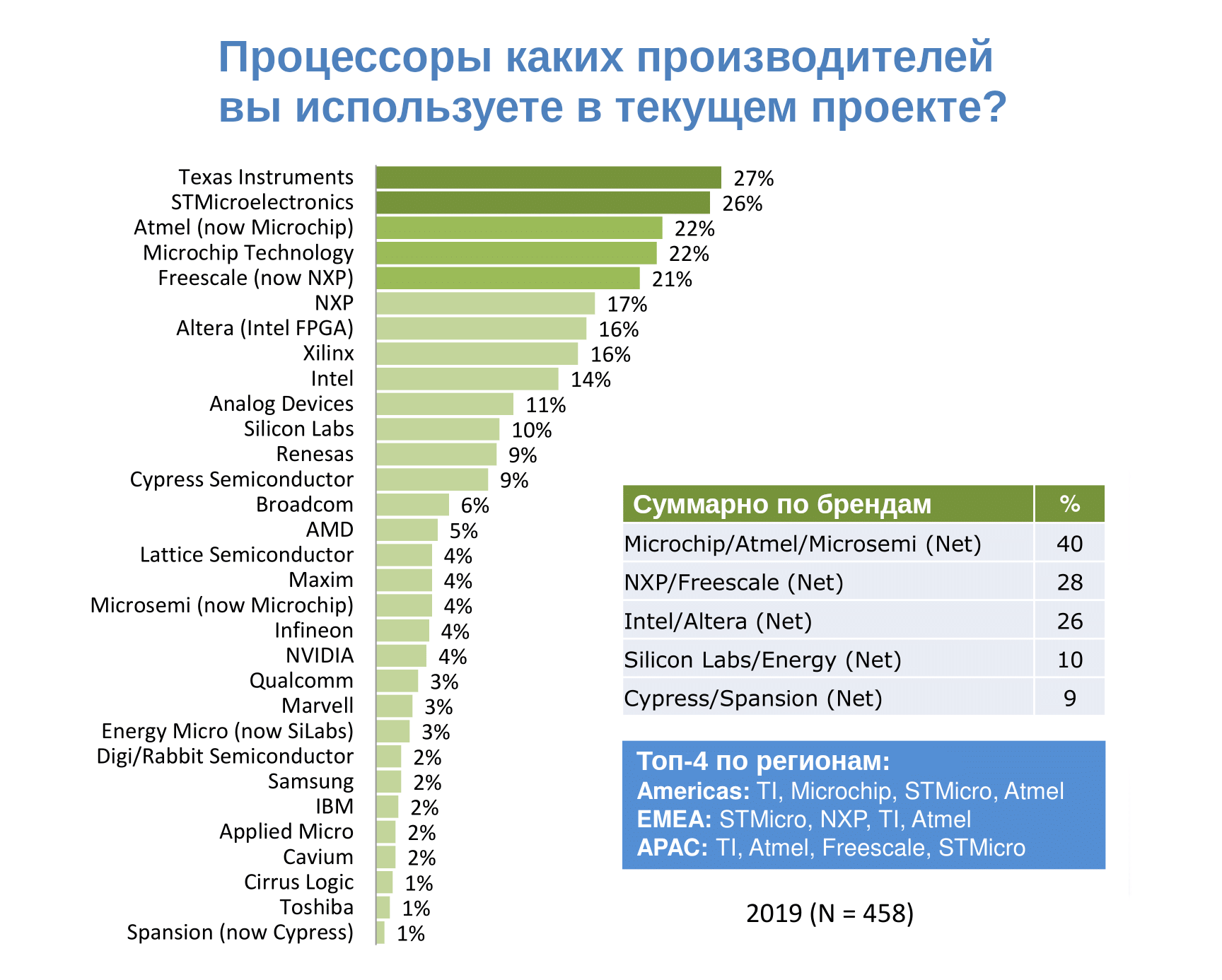
The 2019 Embedded Markets Study by EETimes and Embedded shows the current state and trends in the development and application of electronics. It reflects the latest technologies, software and development tools; used solutions, components, FPGAs and operating systems; organizational issues are touched upon.
This material contains 30 (out of 99) slides and is a compressed version.
A link to the full version is provided at the end of the article.
Foreword:
958 respondents took part in the online survey with the following regional distribution:
58% - The Americas (North and South America).
21% - APAC (Asia Pacific).
21% - EMEA (Europe, Middle East and Africa).
Electronics in the article means "embedded systems" - that is, electronic devices and devices that include a computing module (microcontroller, microprocessor, etc.) and work both separately (for example, a fitness tracker) and as part of more complex devices.
Further, I will give the original slides from the presentation, since the translation for the most part does not make sense and can even distort the information, but with a translation of the title and some comments.
I. General information, IoT, trends, security
What are the areas of application for your current developments?
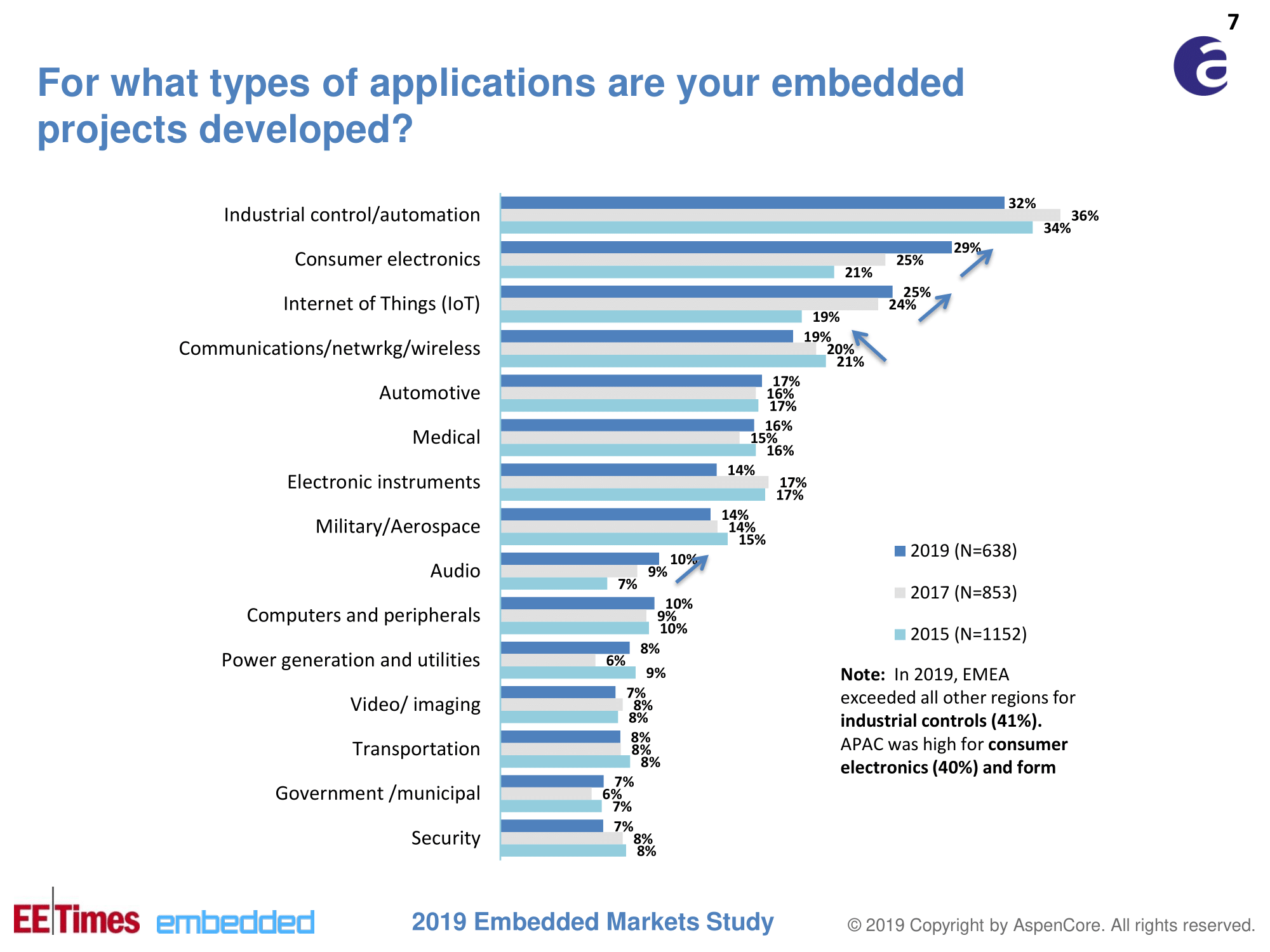
Top 3: industrial automation, consumer electronics, internet of things. Europe works more in manufacturing, Asia in consumer electronics, which is not surprising.
What area are your IoT developments in?
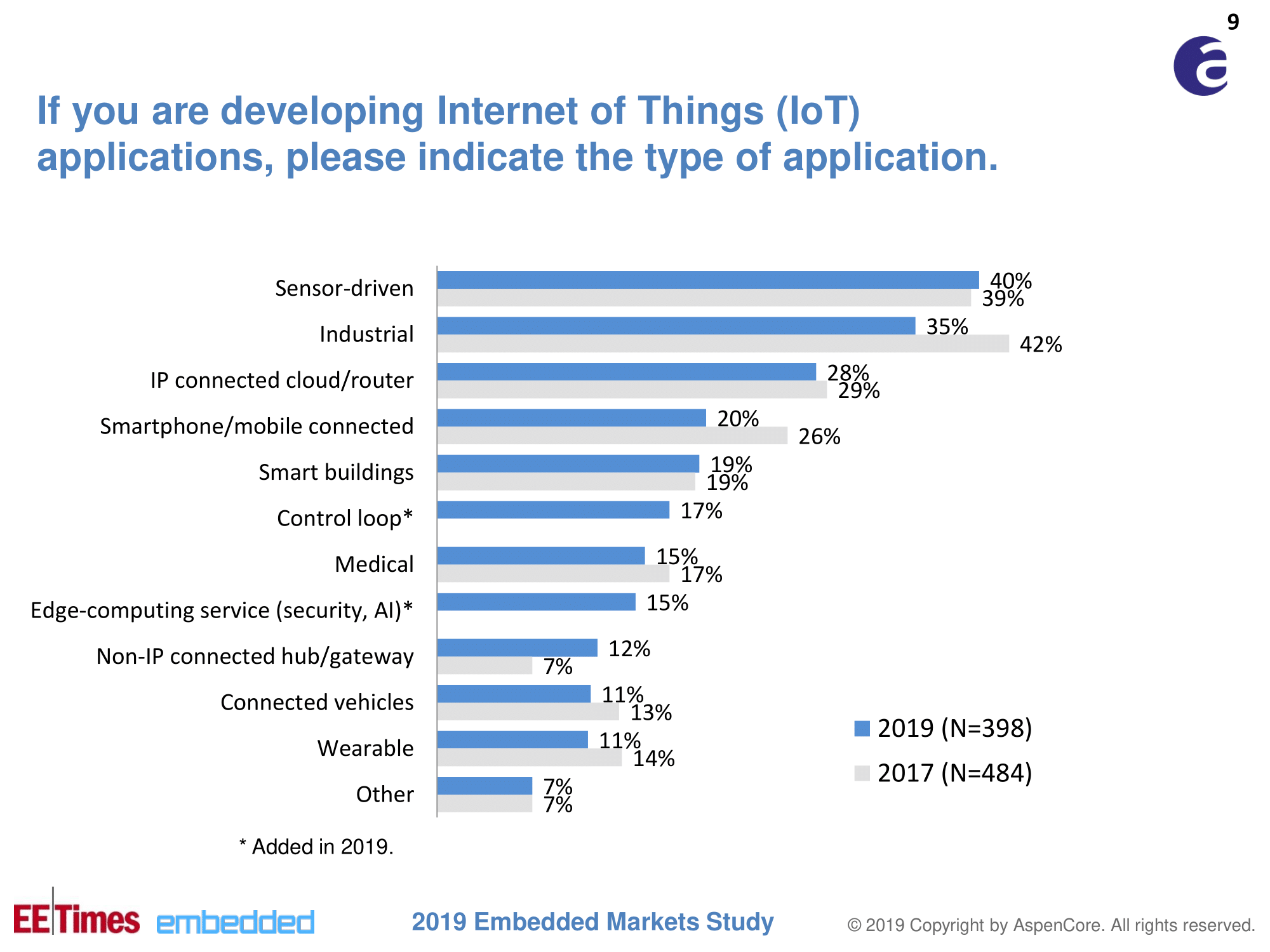
Approximately 40% of respondents are engaged in IoT development. The most interesting and promising areas in the opinion of the respondents:
- automatic movement control;
- augmented and virtual reality;
- smart / automated homes, cars;
- determining the position for the provision of unique content;
- distributed diagnostic and monitoring systems, condition sensors;
- remote medical diagnostics.
Graph of interest in new technologies for 2018
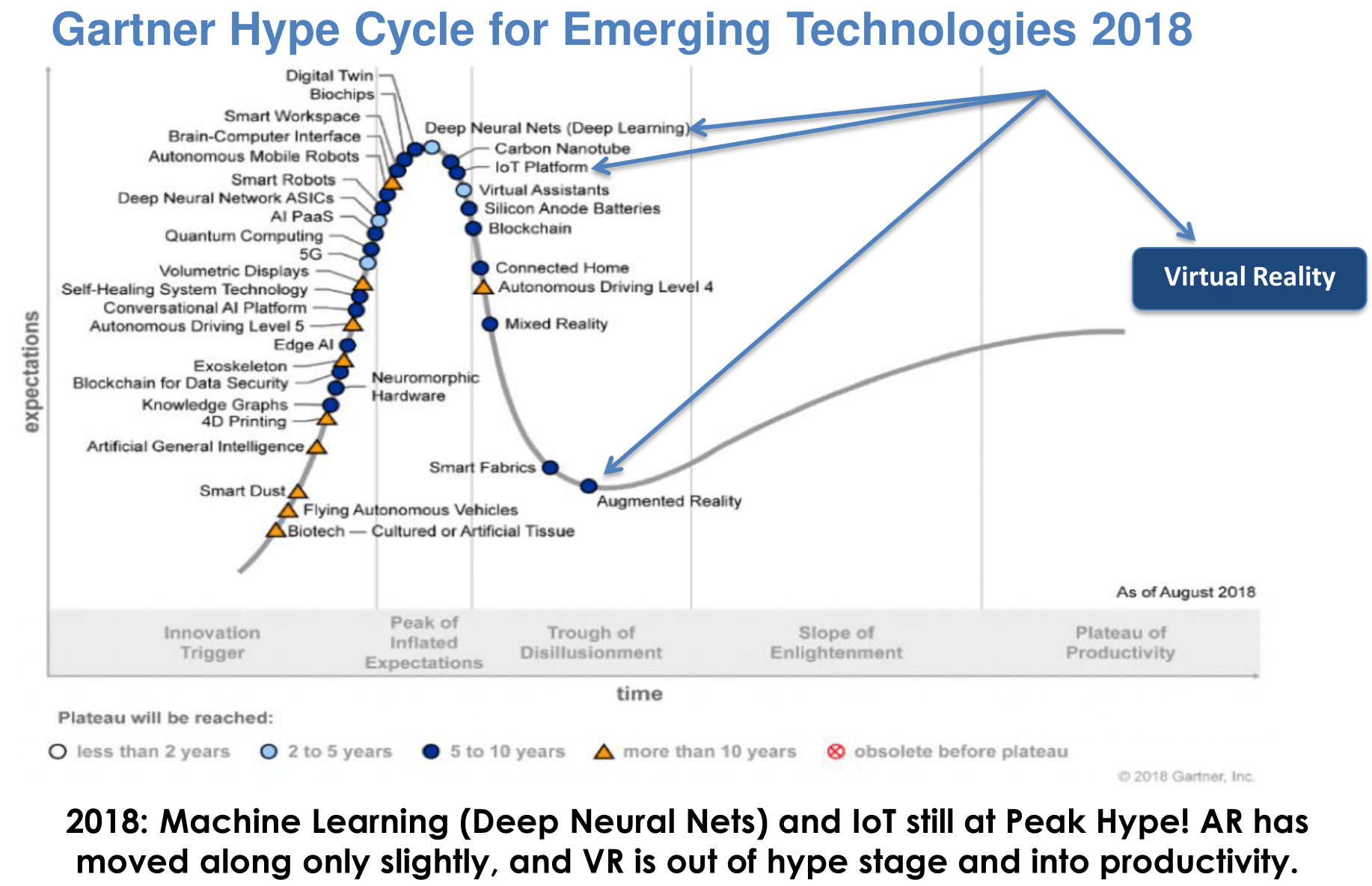
2018: Machine learning and the Internet of Things are still at the peak of hype, augmented reality is on the way to mass use, virtual reality is already a familiar technology. There is no Wi-Fi 6, but we can assume that in a couple of years the new standard will firmly enter our lives, as well as many interesting things based on it. The pdf contains a similar graph for 2015.
Which of the following modern technologies do you use in your developments?
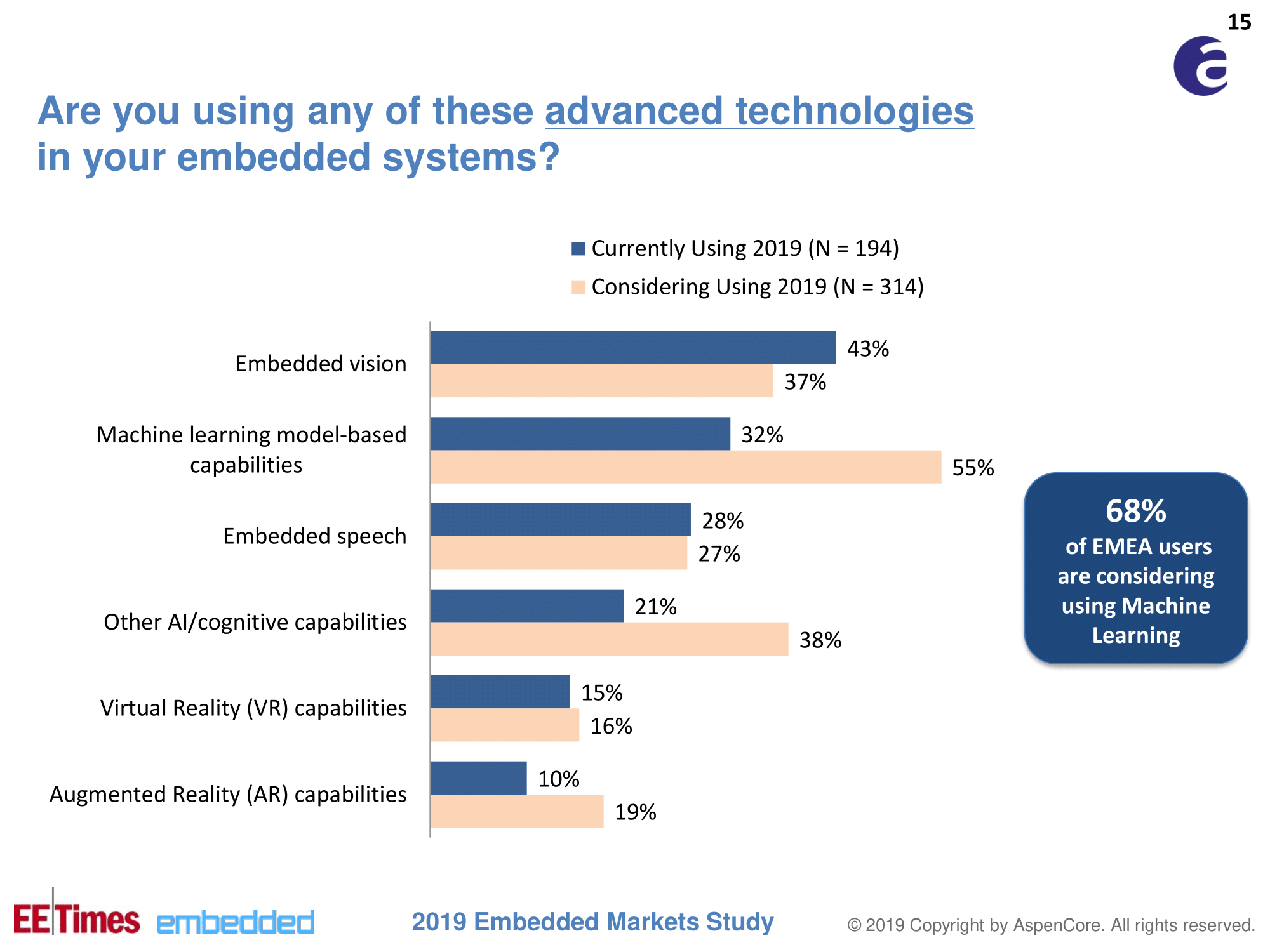
20% of the surveyed developers / companies use one or more cutting edge technologies in their developments and 15% are going to use machine learning in future projects.
Decoding
Embedded vision — , . .
Embedded speech — , .
Machine learning model-based capabilities — ST, : -> -> -> -> -> , Artificial Neural Network in your STM32F* project!
Virtual reality — . .
Augmented Reality — . — , . , , .
Embedded speech — , .
Machine learning model-based capabilities — ST, : -> -> -> -> -> , Artificial Neural Network in your STM32F* project!
Virtual reality — . .
Augmented Reality — . — , . , , .
What security measures are implemented in your designs?

A good trend towards increasing the security of devices. I hope we will soon get rid of the stereotype that electronics engineers pay little attention to safety. So don't forget to lock the firmware and disable intimate interfaces at release.
II. Current developments
Which of the following are included in your current development?
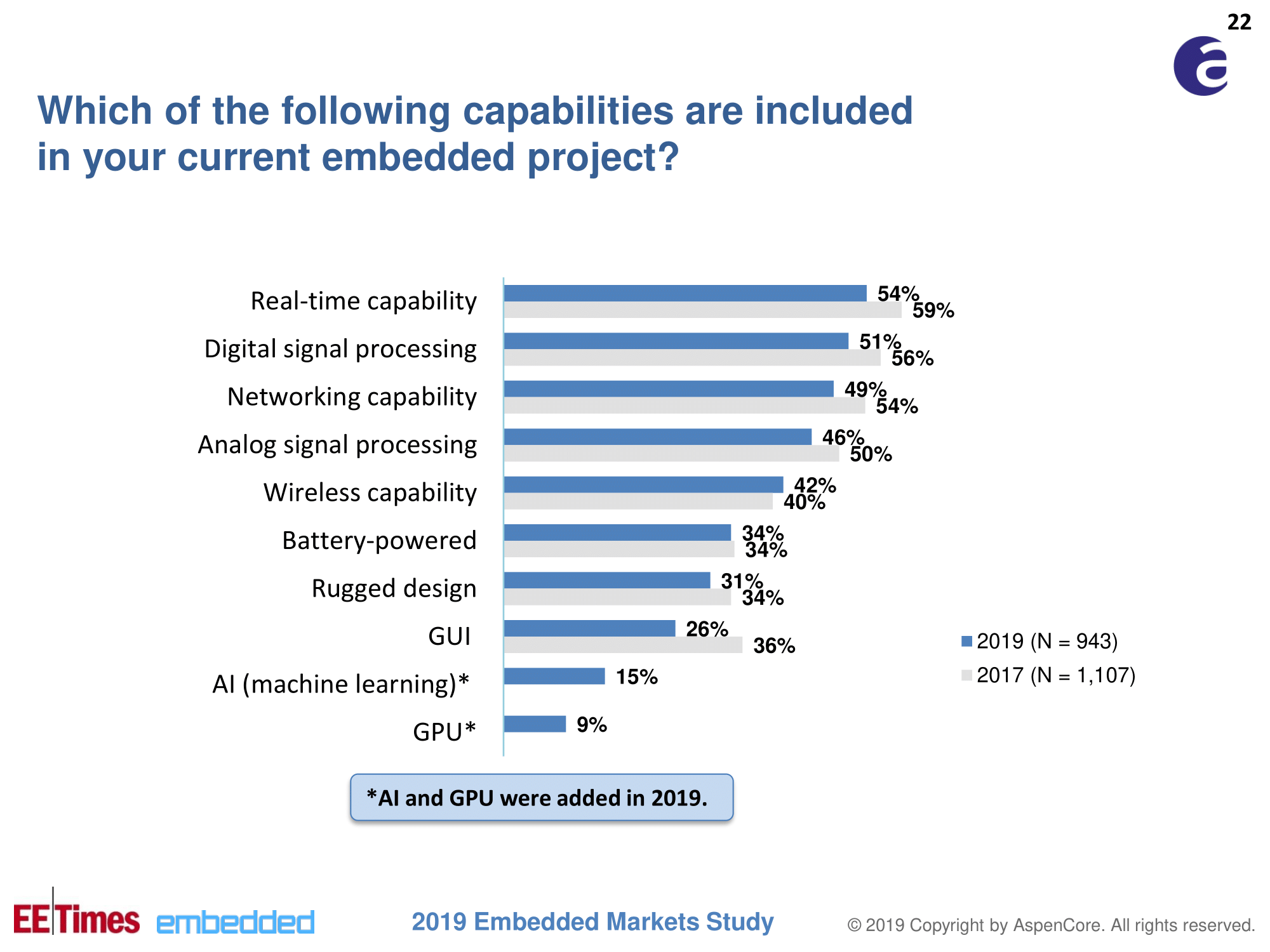
Analytics : Two-thirds of developments are powered by the mains and three-quarters have no user interface.
If your device has a wireless interface, then these are:

40% of projects use wireless interfaces (379 out of 958 respondents). A quarter of all developments use Wi-Fi and / or BlueTooth / BLE.
How many engineering positions are on your team? How are resources allocated between software and hardware development?
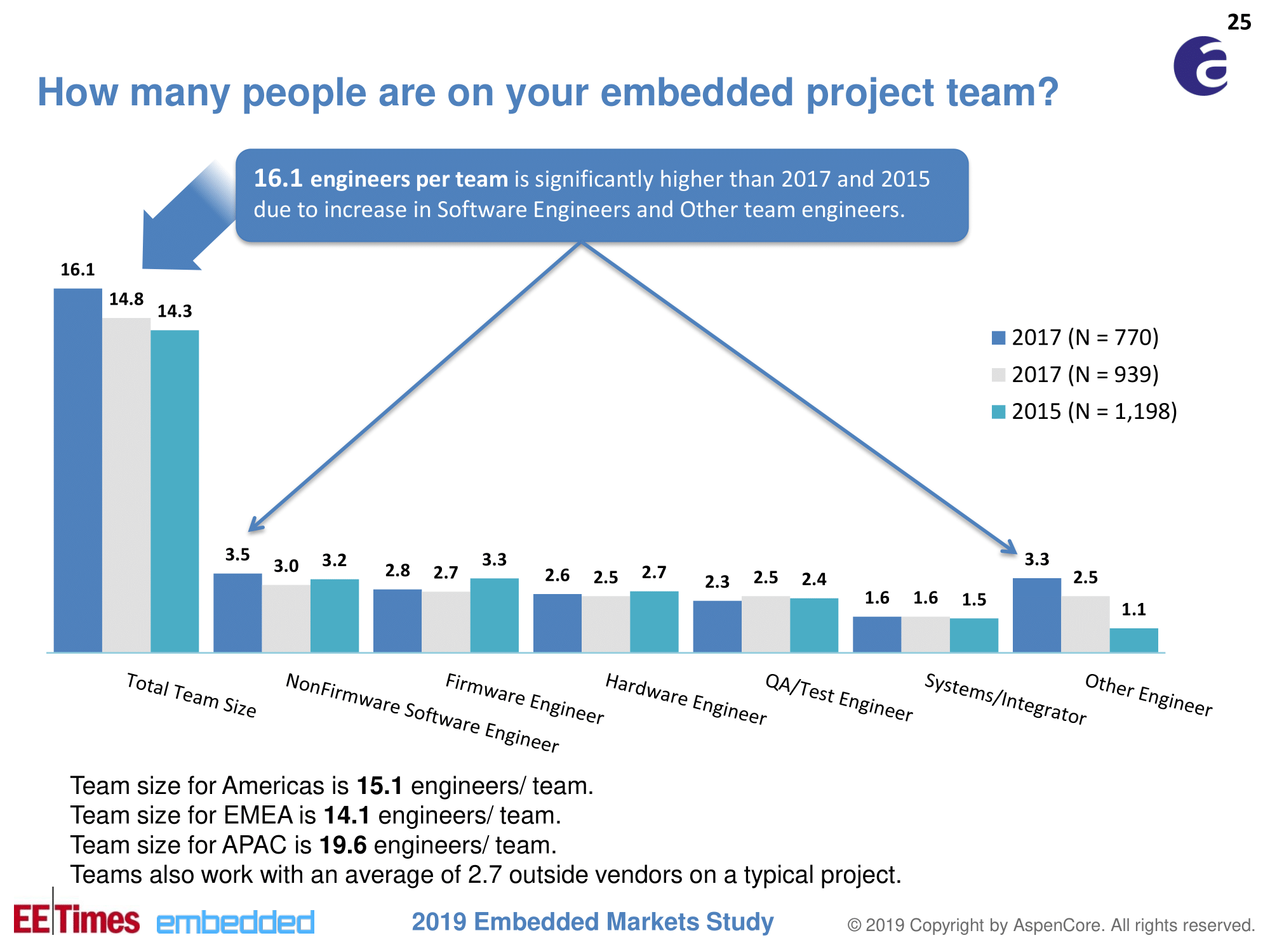
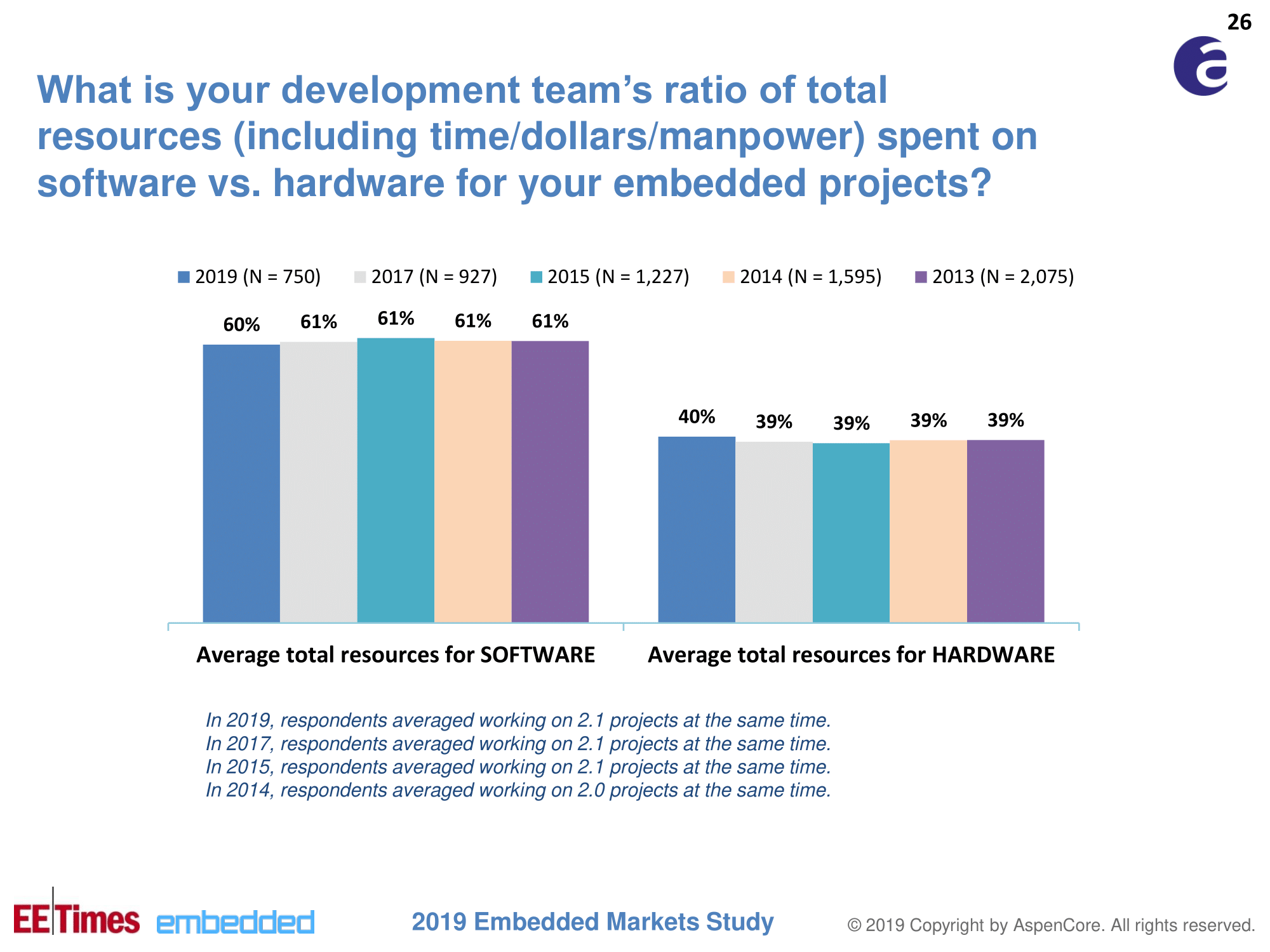
This is probably what the reference command looks like.
Did you use a debug board during the initial development phase of the current project?
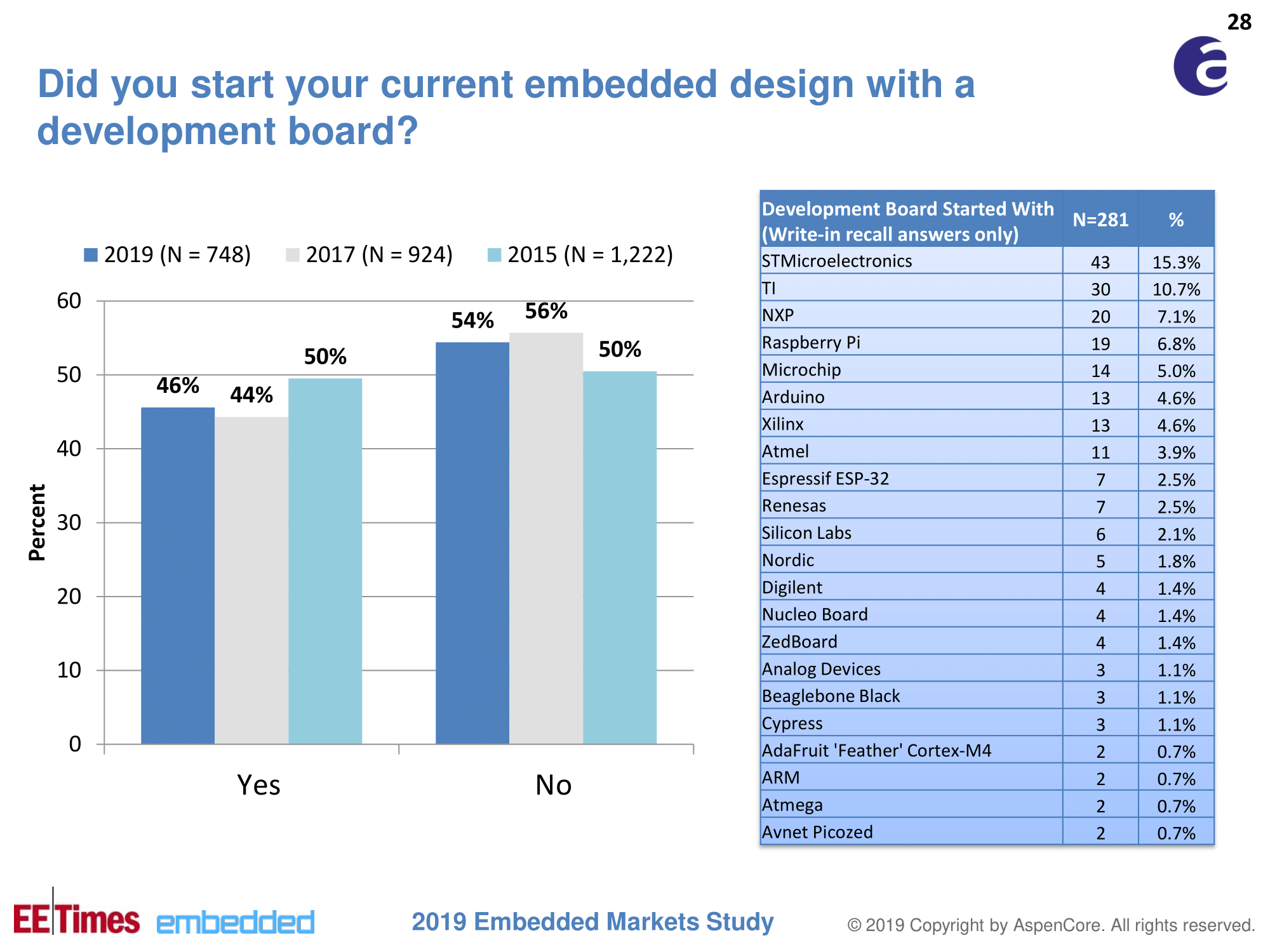
I would like to note the presence of Arduino in 6th place. In the question about the form factor of prototyping boards, Arduino is in 3rd place.
How long have you been developing your last project?

Average development time - 12.2 months. Moreover, in Asia, it will be developed 2.5 months faster than in America.
My current project is written primarily in ...
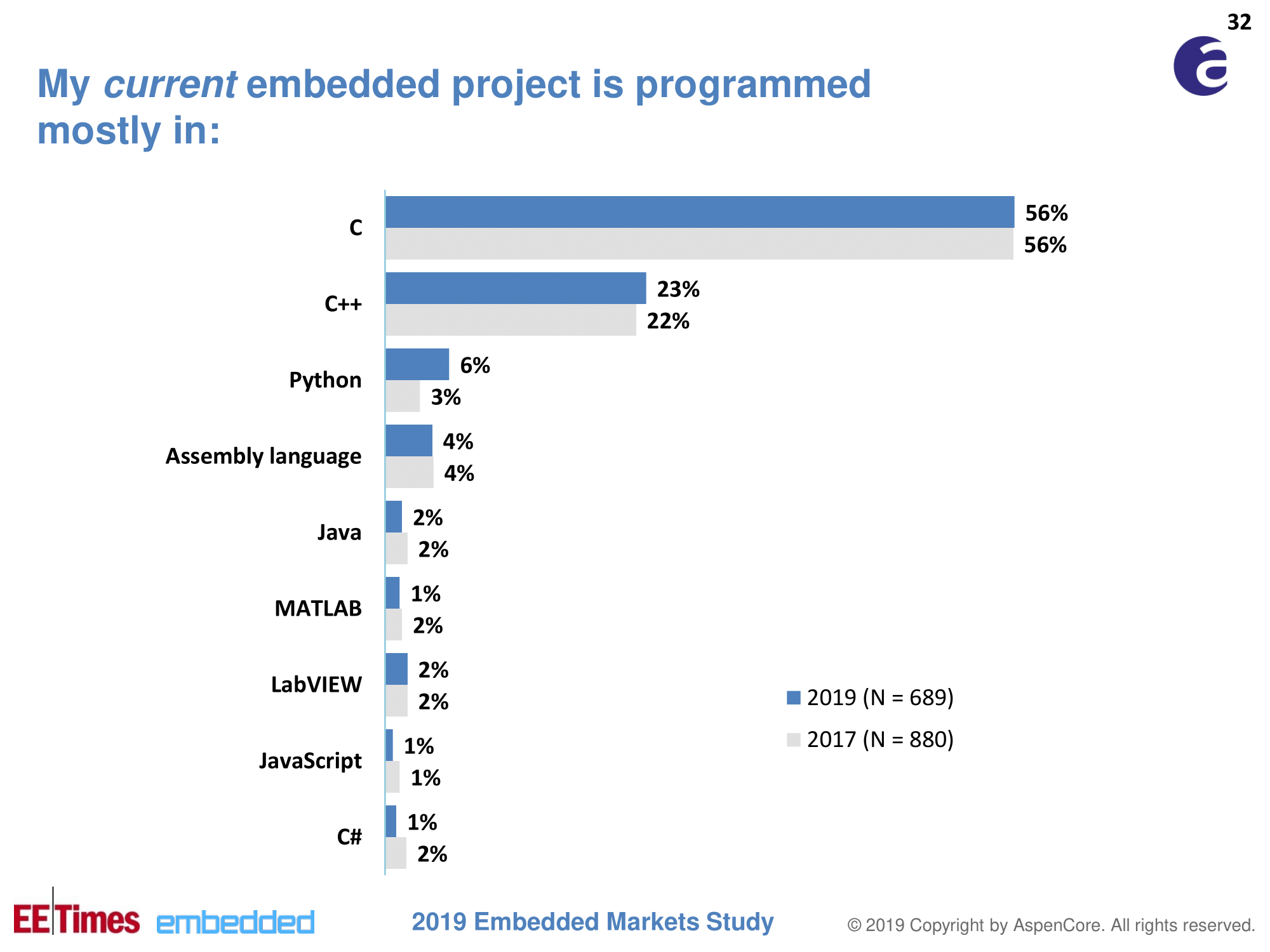
New programming languages will not soon take at least some significant part of hardware development. C / C ++ confidently occupies 80%. There is no mention of Rust, it may appear in 2021.
III. Development process
What tasks in the development process give you the most headaches?
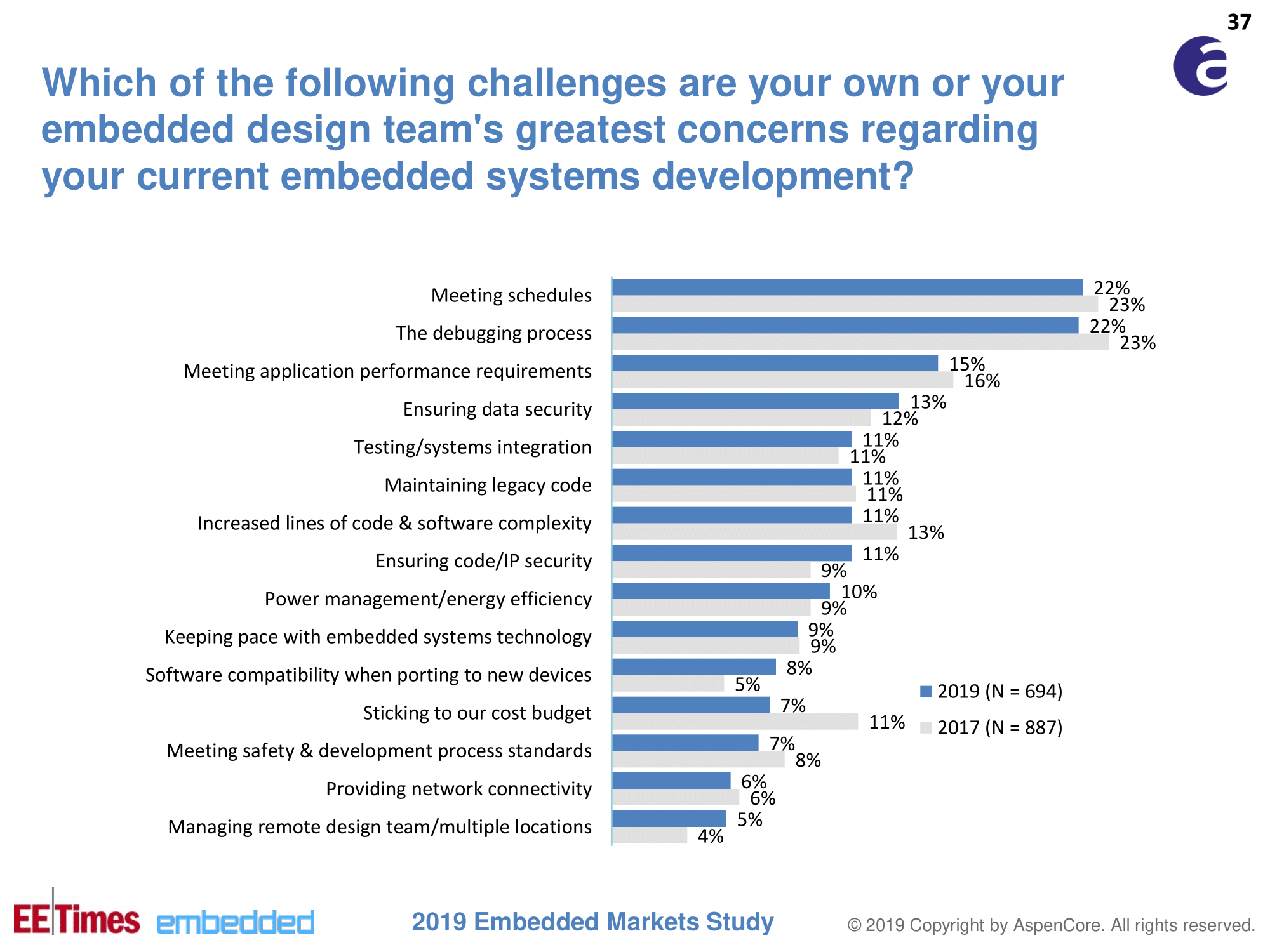
How is time allocated to development stages?

Healthy person schedule . If we take the average time of 12 months from the last slide, then it turns out:
Statement of the problem and development of the technical specification - 1.5 months.
Prototype assembly (Proof-of-Concept) - 1.3 months.
Development of the device itself - 4 months.
Testing and debugging - 2 months.
Production of pre-production samples - 1 month.
Transfer to production - 1 month.
What skills / tools / development components would you like to improve?
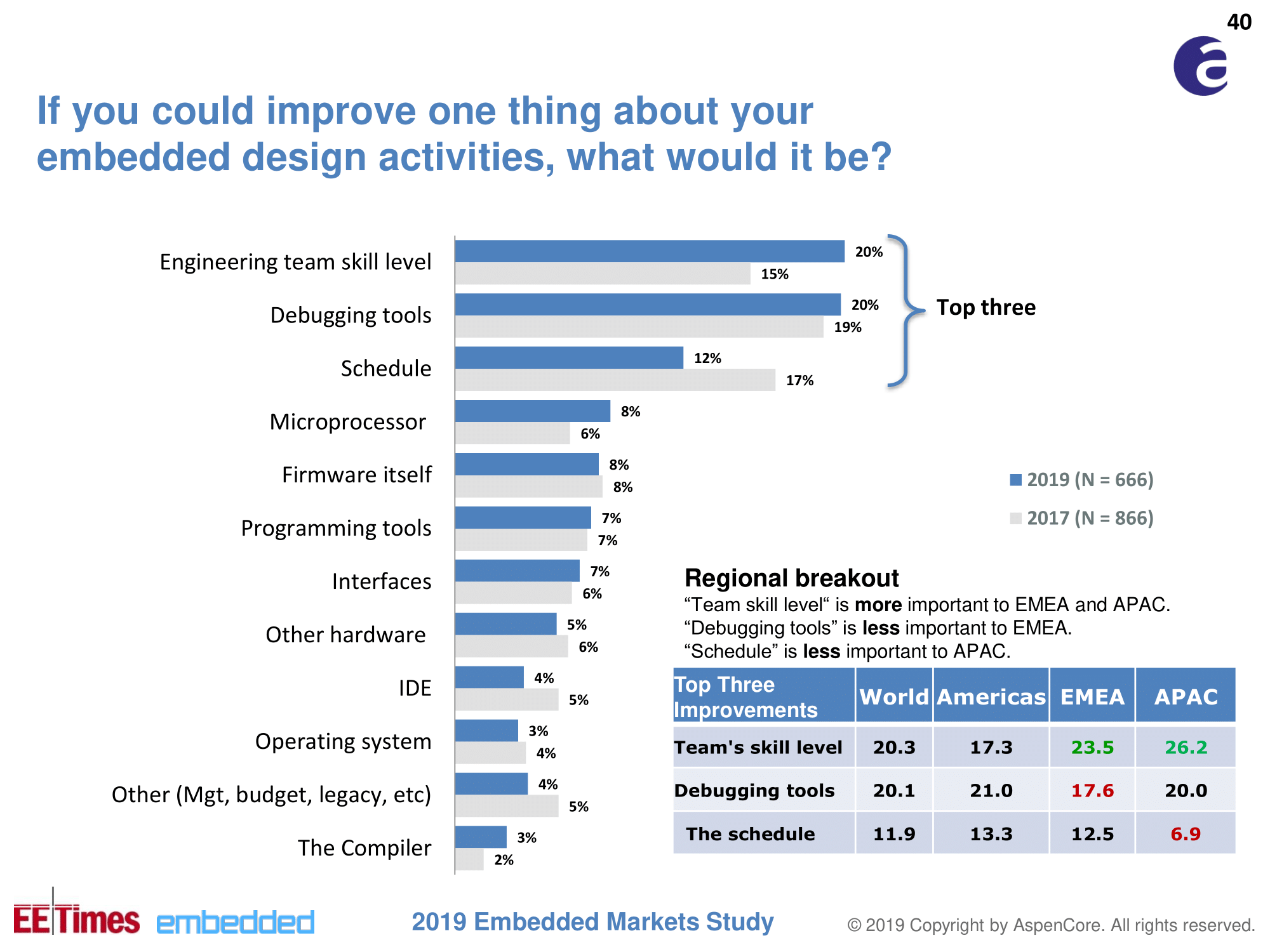
Judging by the answers - everything is in order with the iron. But people and debugging tools are the weak link.
Which of the following are the tools you need most?
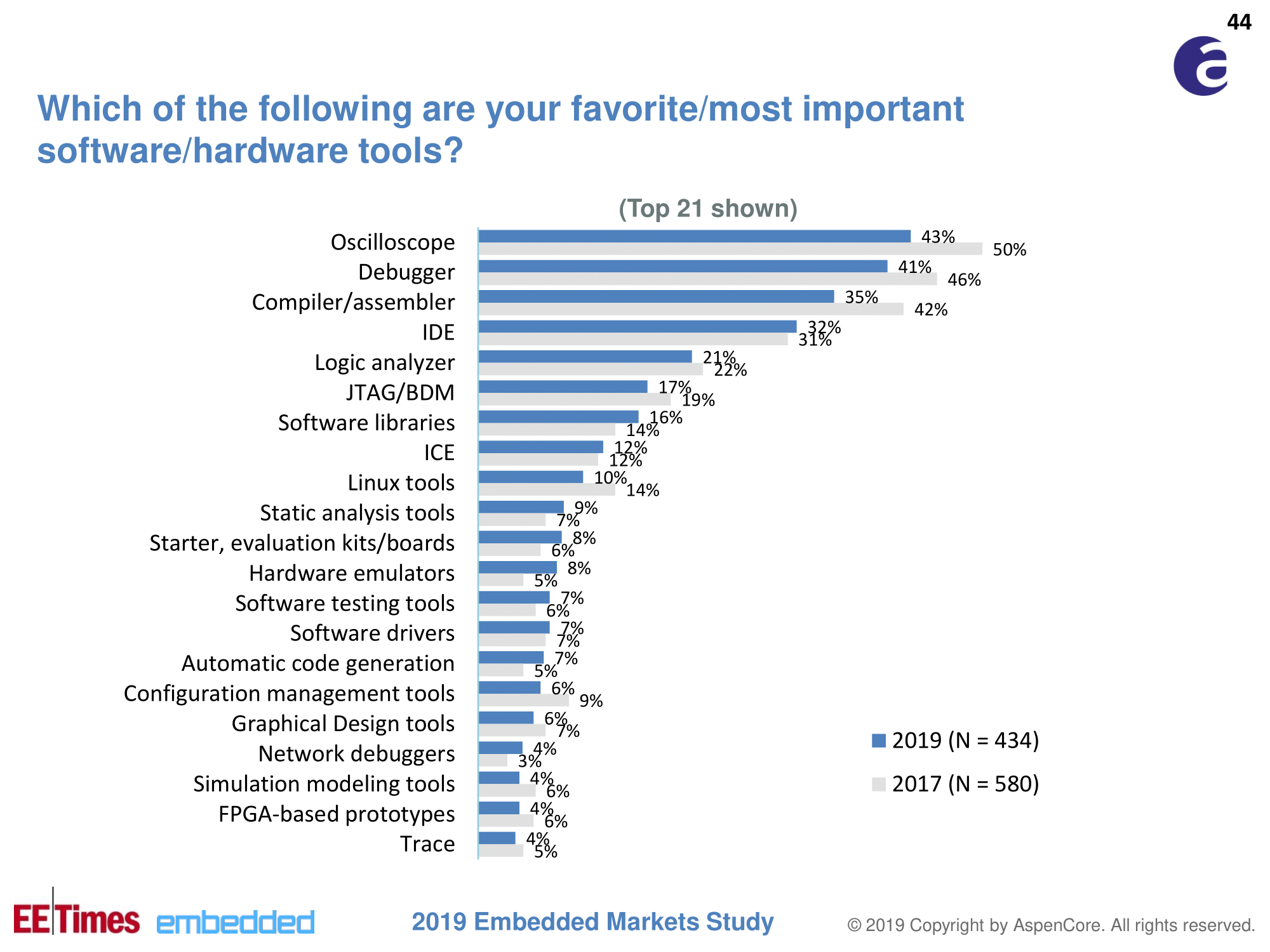
Without an oscilloscope and a debugger, nowhere. And I would add a programmer, this is also a tool. And nowhere without him.
How do you improve your professional level?
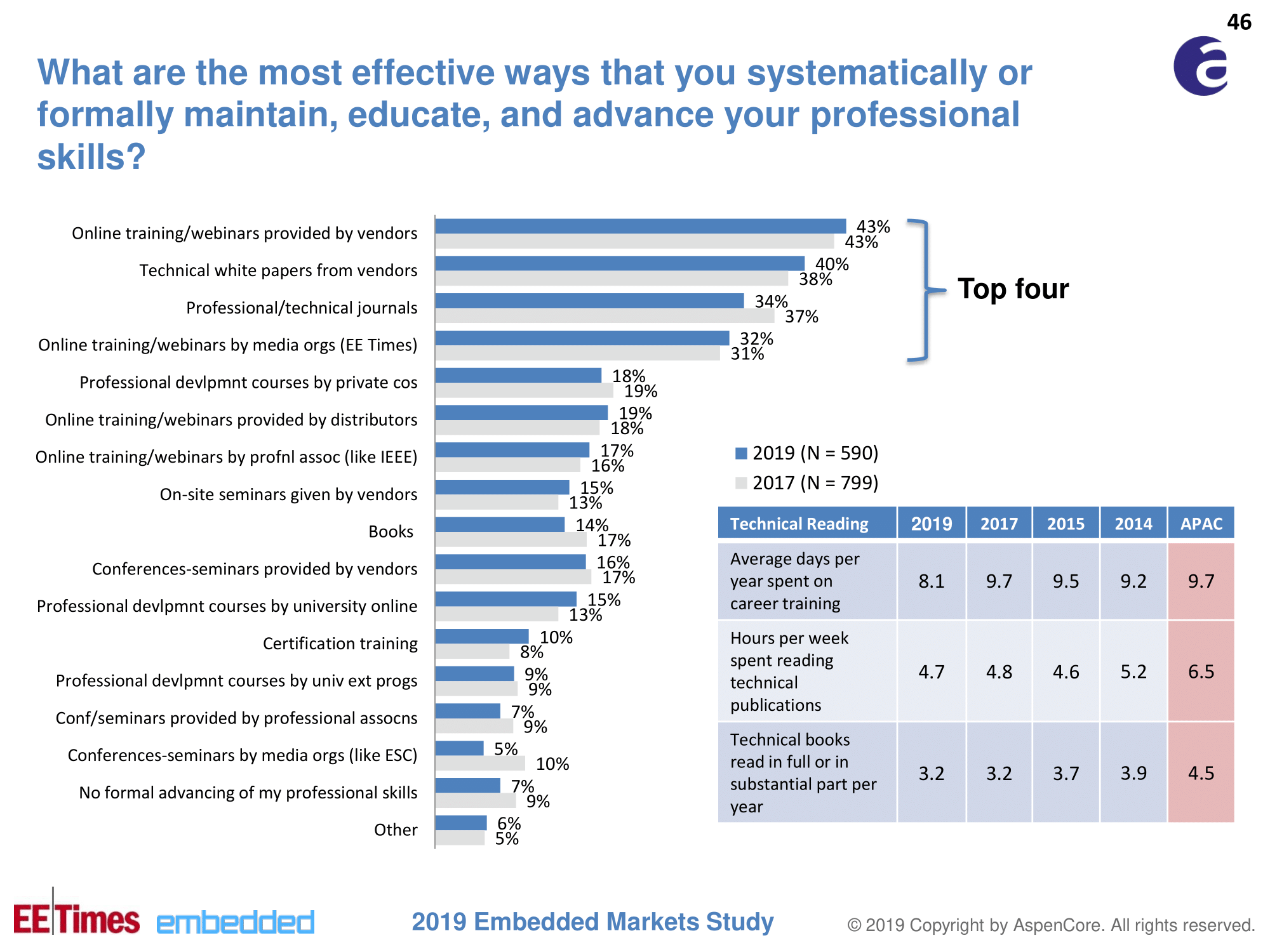
Learning is light. Go to seminars and exhibitions. He who is not constantly learning moves backwards.
IV. OS
Are you using OS in your current project?

2/3 of the developments contain the operating system. Of these:
40% - open source OS;
25% - commercial OS;
20% - self-written operating systems;
15% - open source OS with paid support / distribution.
What is the most important factor when choosing an OS?
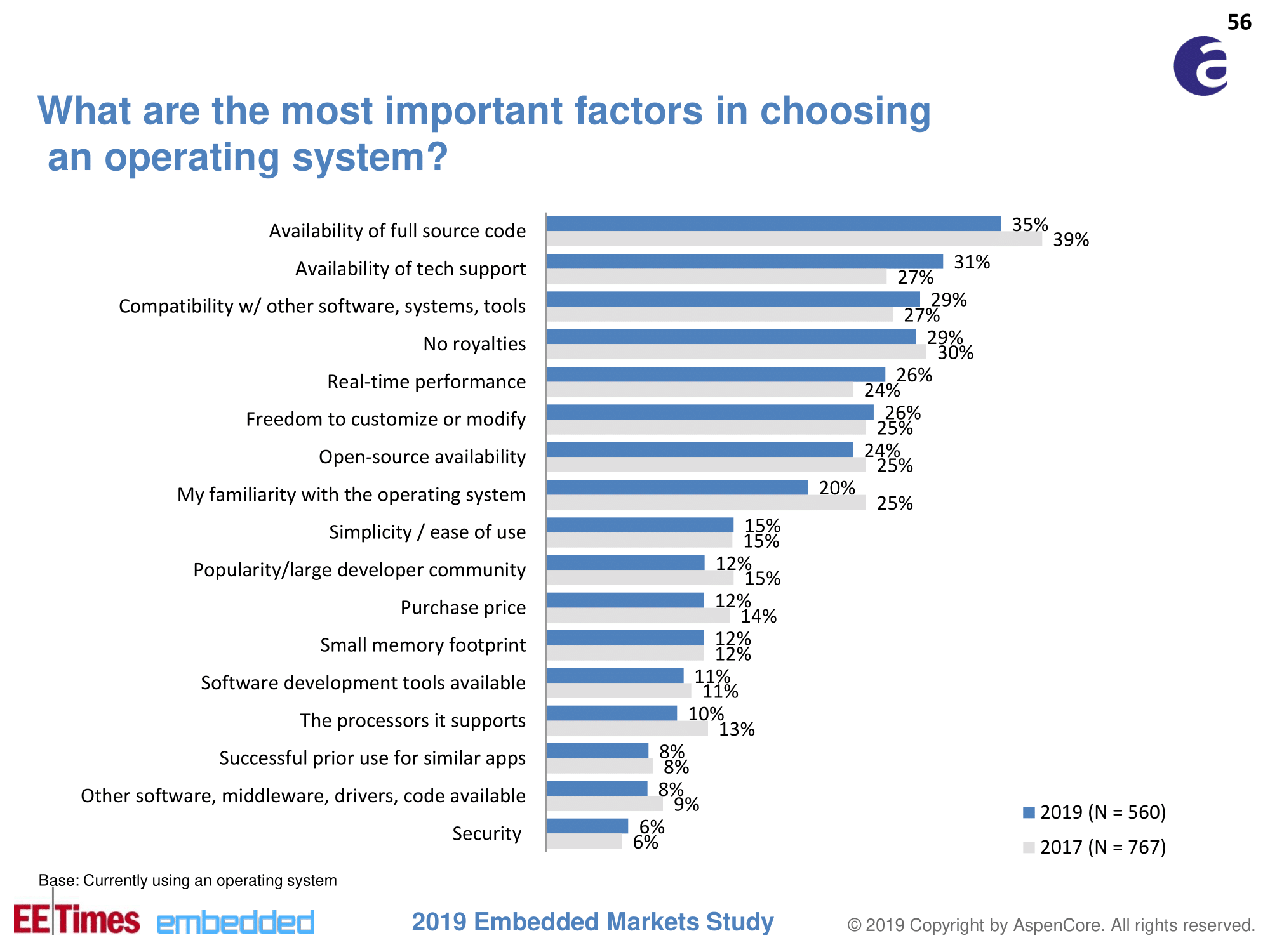
Top 3 - issues of support and compatibility of operating systems, which indicates that the process of implementing and using an operating system in an embedded task is often difficult.
List the OS you are currently using.
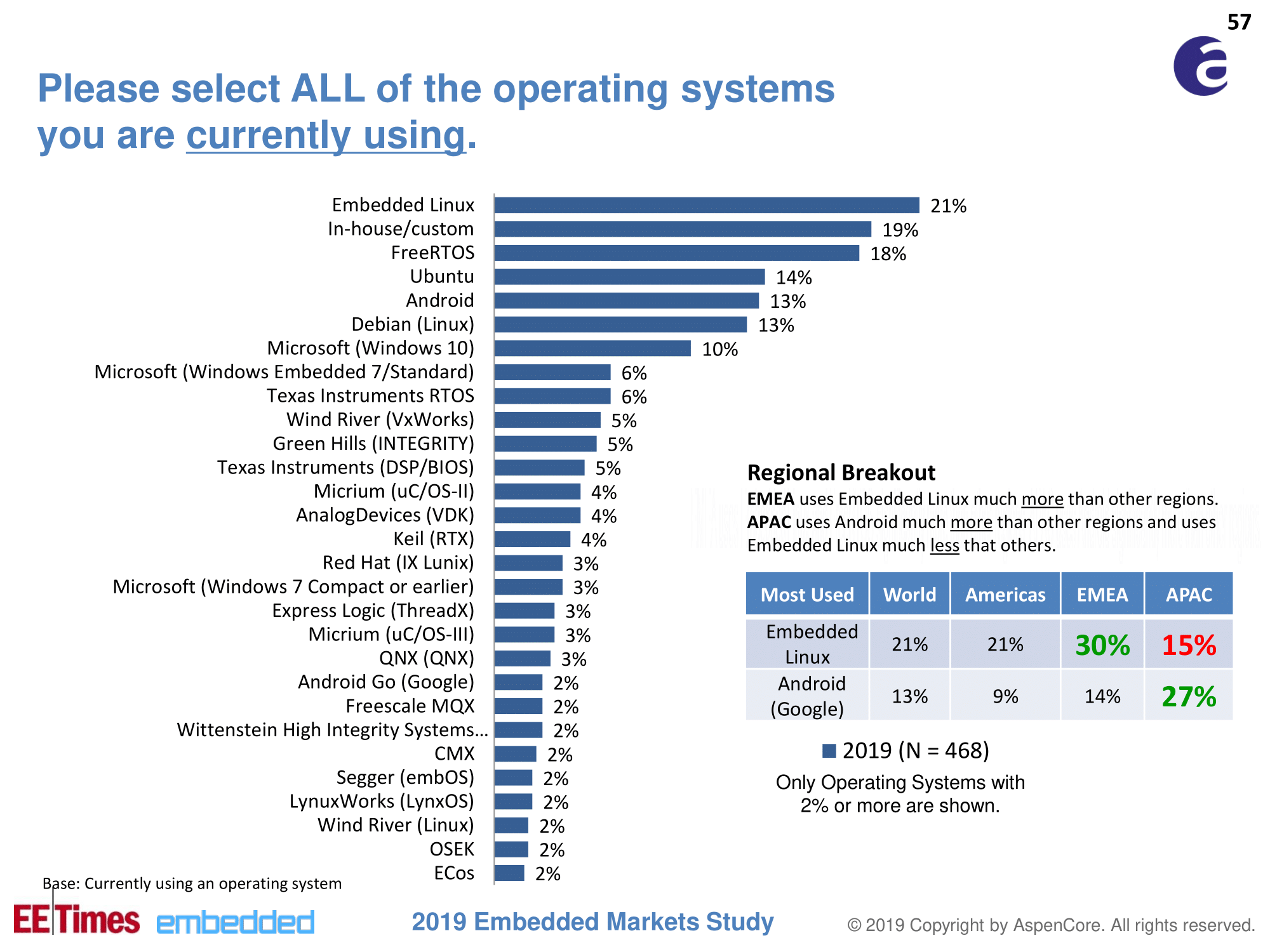
One tip : learn FreeRTOS and Linux.
V. Microcontrollers and Processors
Who is the most influential in the platform selection process?
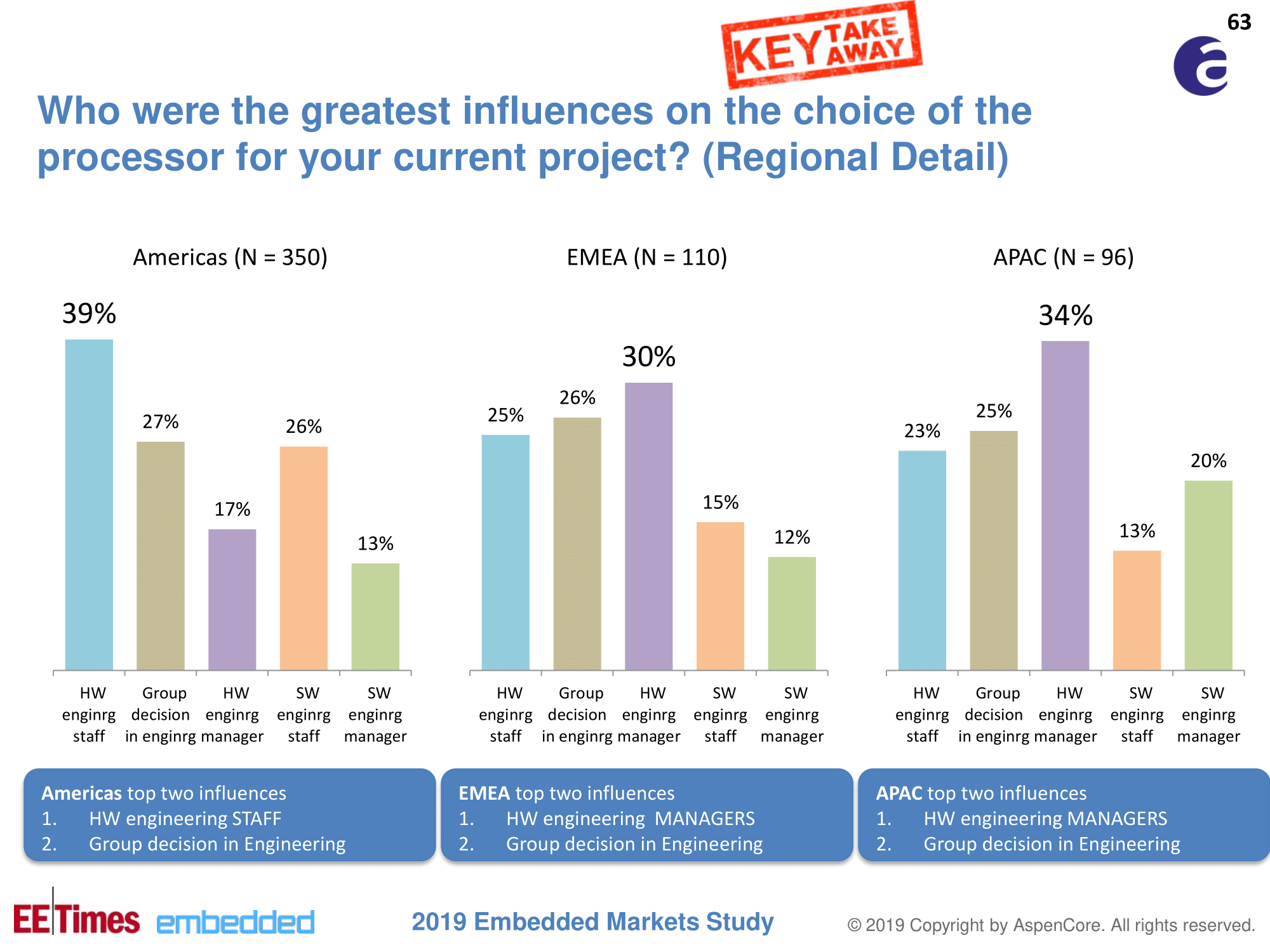
Whereas in the Americas it is engineers who decide, in Europe and Asia, MANAGERS have the greatest influence.
My main processor is:
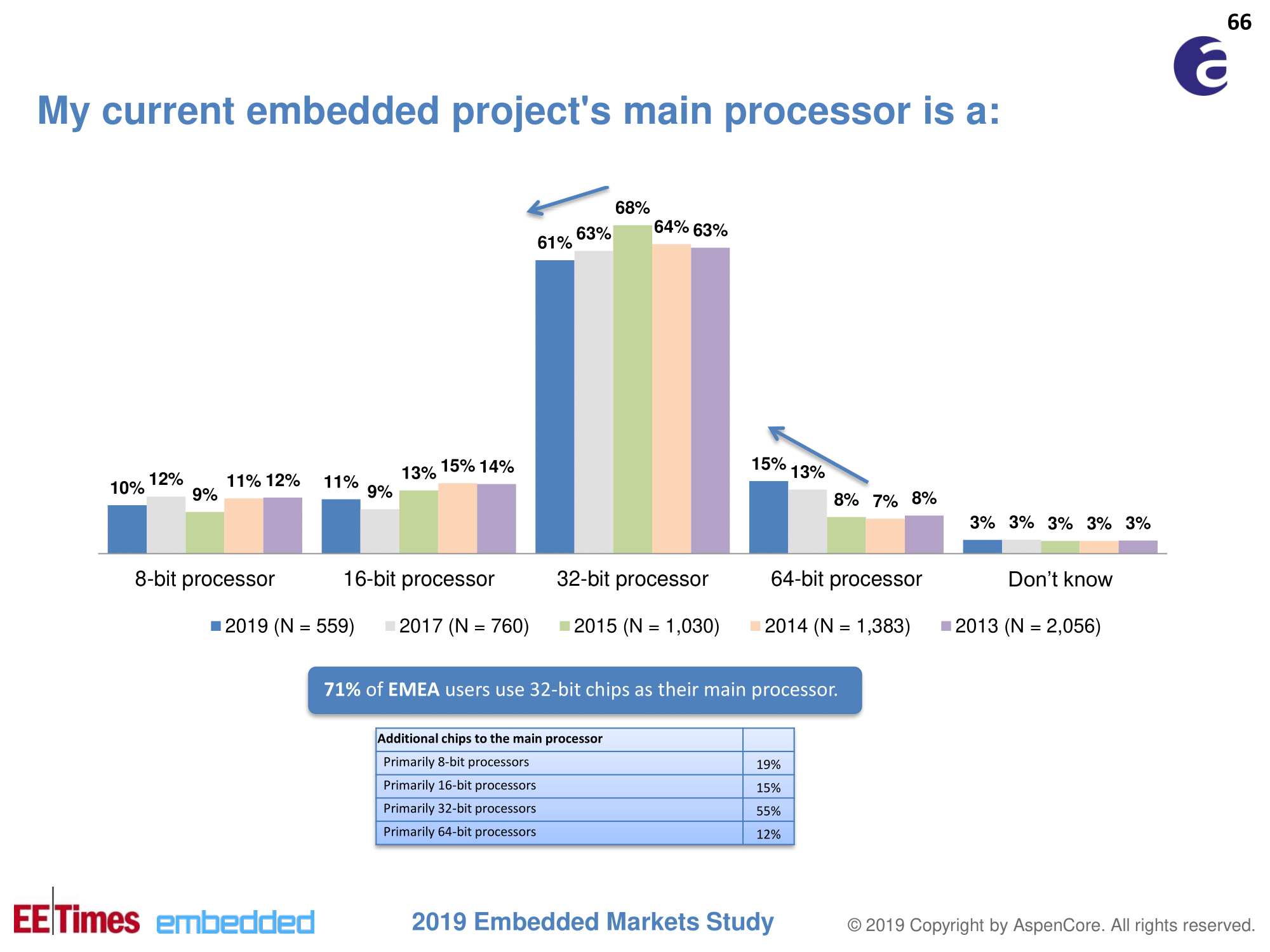
8 and 16-bit mk have long occupied their niches and will remain there for a long time. The 32-bit architecture is losing ground, among other things, due to the development and cost reduction of SoCs (SkN - systems on crystal) with 64-bit processors on board. For example, the iPhone 5 had a 32-bit Apple A6 SoC, and the iPhone 5s had a 64-bit A7.
Work frequency:
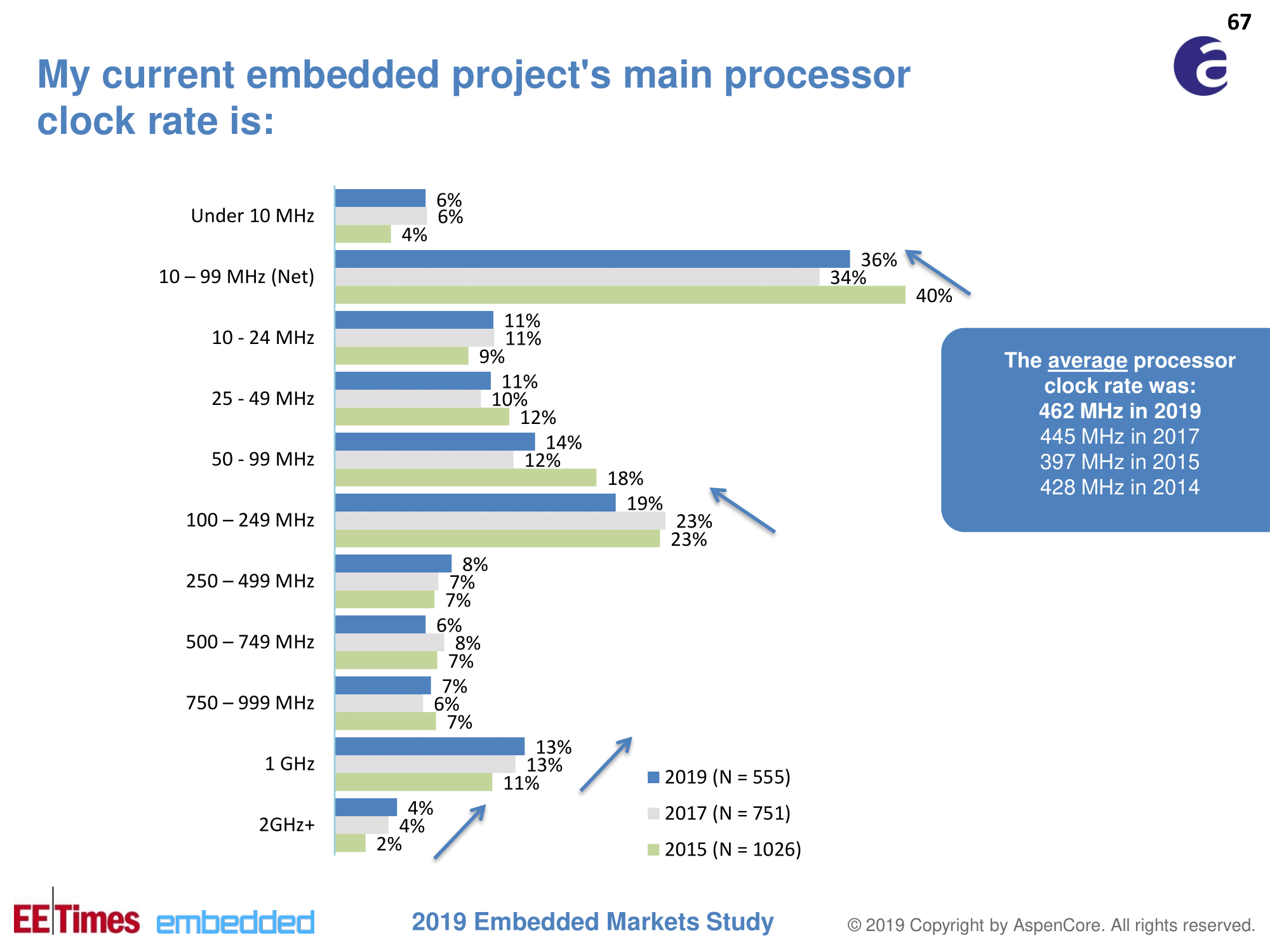
Slowly but surely, the average frequency rises.
The most important factors when choosing a processor:
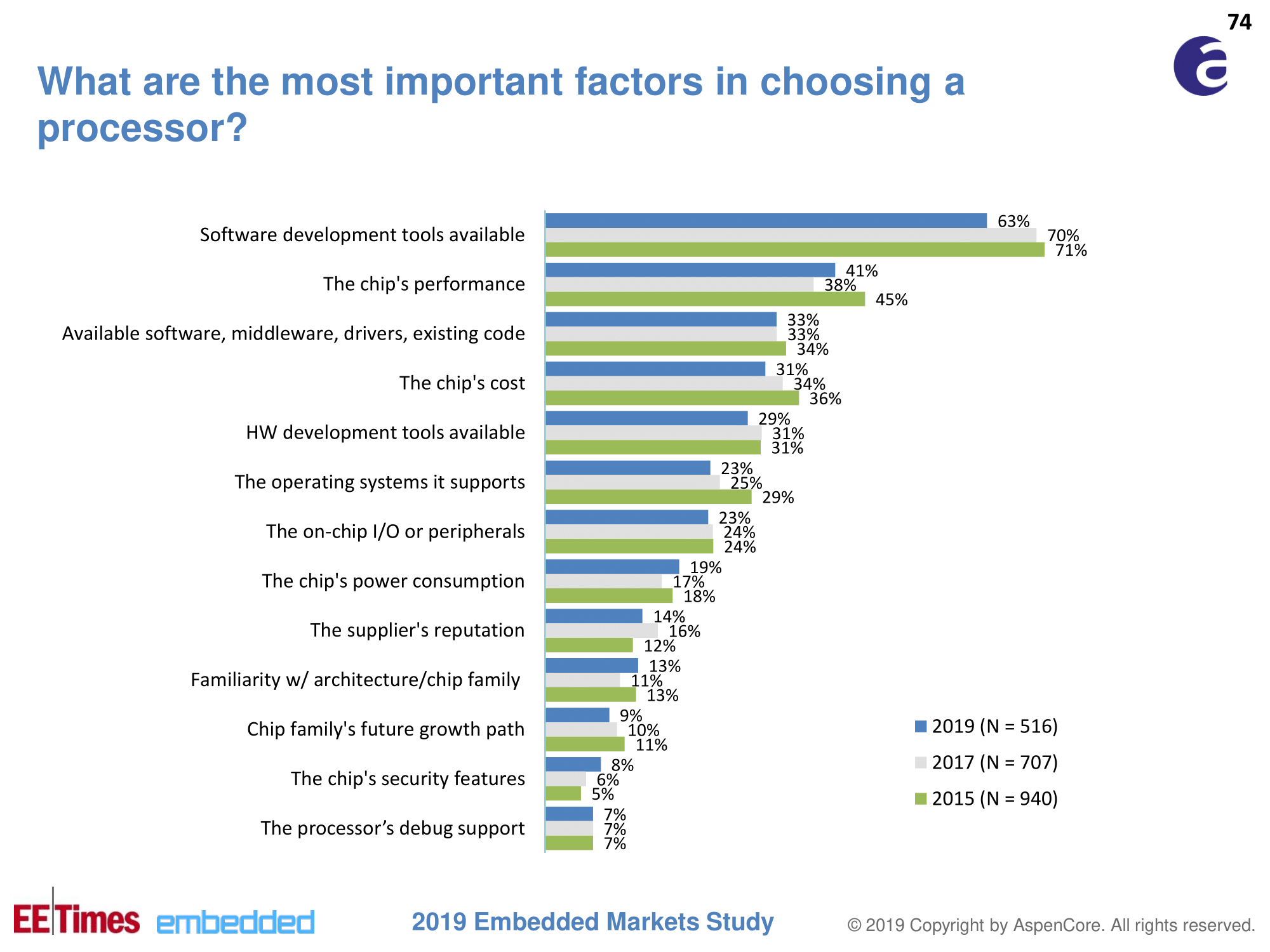
Even fast and cheap microcontrollers will be reluctant to buy if comfortable and affordable development tools are not available.
What processor / controller manufacturers are you familiar with:

I should go to the TI website and get to know them better.
Which 32-bit chip will you use in your next project?
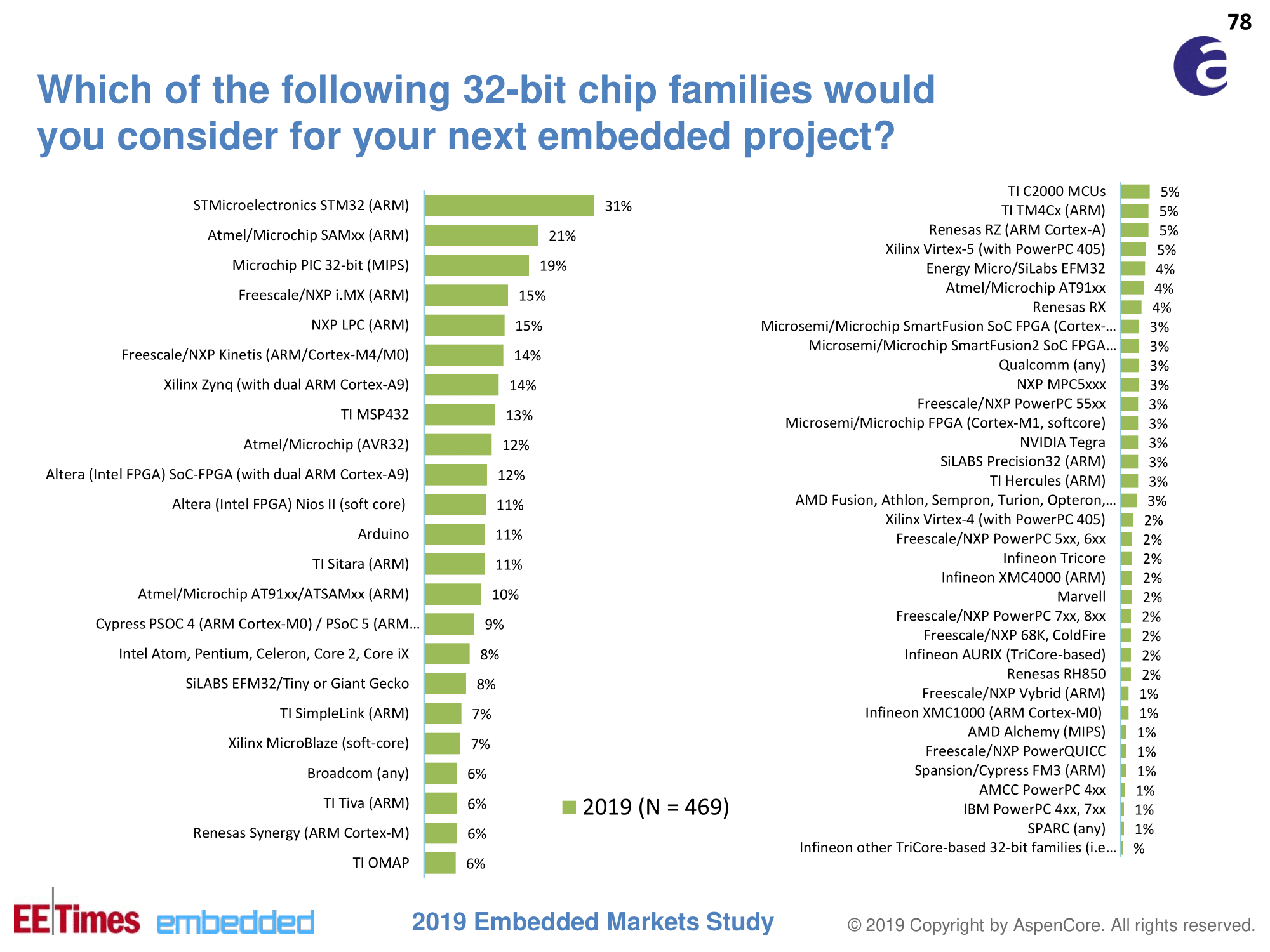
BluePill - a debug board with STM32 on board for 100 rubles, obviously significantly increased the applicability of this family.
Vi. FPGA
Does your current project contain FPGAs?

What chips are you using in the current project?

The reasons for not using FPGAs: not necessary, expensive, consumes a lot of power, difficult.
Vii. Other
What version control systems do you use

Not surprising.
I hope this information was at least interesting and shed light on such an interesting and, of course, very important industry, as the production of electronics.
Link to the research article and the pdf itself .